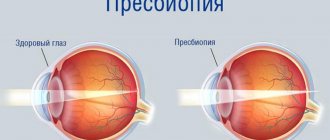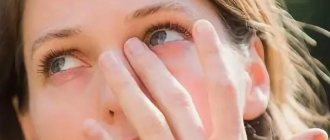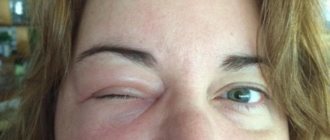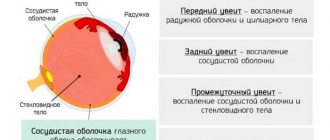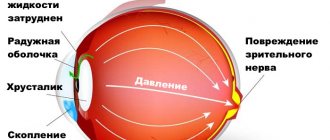What is accommodation?
An important link in the functioning of the visual mechanism is accommodation. This is the name given to the ability of the lens to tense or relax when seeing at different distances. Accommodation is the normal physiological state of the eye, when all muscles are relaxed when looking into the distance. When viewing nearby objects, the ciliary muscle tenses, and the lens increases its curvature, becoming more convex. Its optical power increases, and the near image becomes clear. Defocus of vision occurs precisely because the lens loses its ability to focus. Let's consider what factors can provoke the appearance of this visual pathology.
Glasses will help you see near and far equally well.
One of the popular methods of vision correction for myopia and the most common in children is glasses. The principle of their operation is based on reducing the refractive power of the eye to such values that the focusing of light rays falls exactly on the retina. Myopia glasses have negative power lenses that help shift the focus to the retina, allowing the eyes to see far and near with equally good clarity. Often, a patient is diagnosed with astigmatism along with myopia. In this case, ordinary monofocal glasses will not be able to restore the necessary clarity of vision; special astigmatic models with “cylinder” lenses will be required. For myopia, the doctor may prescribe glasses for constant or periodic wearing, depending on the goals of correction, the degree of myopia, the patient’s age and other factors.
The main advantage of spectacle correction for myopia is its versatility, ease of use, and accessibility for people of any age and occupation. However, not everyone likes how glasses change their appearance, and teenagers may even be ashamed of their “bespectacled” image and refuse the necessary correction. In this case, you should consult your doctor about the possibility of switching to contact lenses.
Causes of blurred vision
This disorder can occur in a person for a number of reasons:
- Age-related changes in eye structures.
- Eye strain associated with prolonged exposure to a monitor or gadget.
- Improper organization of the workplace: poor lighting, low table.
- Hereditary myopia.
- Lack of sleep, lack of fresh air, insufficient physical activity.
All of these factors can provoke a spasm of accommodation, and its symptoms are such that a person may not be aware of this visual anomaly for a long time until the disturbances become too obvious.
Often, blurred vision is mistaken for fatigue from lack of sleep or intense visual work.
This can last for quite a long period and, if appropriate measures are not taken, will lead to a serious deterioration in eye health. Let's consider the possible causes of blurred vision known in medical practice.
Why is progressive myopia dangerous?
If myopia progresses, it poses a serious threat to vision. Stretching of the eyeball becomes pathological, leading not only to a decrease in visual acuity by more than one diopter annually, but also to disruption of the nutrition of the eye tissues, ruptures, detachments and degenerations of the retina, and opacification of the vitreous body. With complicated progressive myopia, a person sees worse and worse, and any hard work or sudden movement can lead to damage to the retina and, as a result, a sharp fall or complete loss of vision.
That is why one of the most important tasks of ophthalmology is the stabilization of myopia.
Presbyopia
After 40-45 years, noticeable age-related changes begin not only in the entire body, but also in the visual apparatus. In most people at this age, the lens gradually loses its elasticity - this phenomenon is called presbyopia, or age-related farsightedness.
Near vision begins to get worse. Here is how the symptoms of this pathology manifest themselves:
- difficulty reading small letters close up, for example, on food packaging;
- eye fatigue;
- frequent headaches.
By the age of 60-70 years, the lens loses its ability to accommodate in most people.
Defocusing vision in elderly patients, unfortunately, cannot be treated.
To correct presbyopia, progressive glasses or multifocal contact lenses are used. In the case of a severe degree of this visual impairment, a lensectomy is performed - replacing the natural lens with an artificial intraocular lens. Good quality of vision after such an operation lasts for life. In addition, replacing the lens is a good prevention of cataracts, another common disease in old age, because the artificial implant cannot become cloudy.
More details about the problem
When you have trouble seeing at a distance, but good up close, this condition is called myopia, or myopia. In colloquial speech you can hear such synonyms as “minus” or “minus vision”.
The main symptom of myopia is the complaint that a person sees well up close, but poorly far away. It shows up like this:
- blurry indistinct contours of distant objects;
- inability to recognize the faces of acquaintances on the street;
- difficulty reading store signs;
- rapid eye fatigue;
- headache.
Myopia occurs in both adults and children. The child may also have trouble seeing into the distance. This happens with a congenital form of myopia or acquired. The acquired form develops due to high load on the eyes during training or against the background of other ophthalmic pathologies.
Poor vision at long and near distances occurs with astigmatism. A person with this pathology sees blurred, the outlines of objects are unclear, and rapid eye fatigue is noted.
Blurred vision occurs with cataracts. A person sees at any distance as if through a white veil. Additionally, floating flies and bright halos appear around objects.
Accommodative visual asthenopia
Asthenopia is the name given to rapid eye fatigue that occurs during intense visual work. In medical practice, it is classified not as an independent pathology, but as a disorder that precedes pathological deterioration of vision and in other cases leads to eye diseases.
Symptoms of asthenopia are expressed as follows:
- pain in the eyes, increased lacrimation, fatigue during visual work;
- headache;
- ghosting;
- sensation of film in the field of view.
The causes of accommodative asthenopia can be prolonged exposure to a computer monitor - currently this is the most common factor causing it. Eye strain often occurs when driving a car, reading for a long time or working with small parts, or watching TV for many hours. The development of this visual anomaly can also be caused by incorrect selection of contact optics for myopia or astigmatism. Blepharitis and conjunctivitis often develop from constant eye strain.
Prevention of accommodative asthenopia requires adherence to the regime, and a properly equipped and lit workplace is also important.
Every hour you should take breaks from work for 10-15 minutes.
Why does my left eye become blurry?
No specific causes of blurred vision on the left side have been identified. Mechanical actions and infectious diseases can cause clouding of only one eye. Often, cloudiness in the eye appears due to the entry of a foreign body. Severe scratching of the eye causes irritation of the membrane with a corresponding deterioration in visibility. Doctors identify indirect factors that contribute to impaired visual perception. These include chronic diseases, alcoholism, stress, physical and mental fatigue.
You can’t leave the problem unattended, hoping for its quick disappearance, but you shouldn’t self-medicate either. Incorrect actions will lead to complete loss of vision. If your eye becomes cloudy, it is recommended to immediately contact an ophthalmologist and undergo the examination prescribed by him. Treatment of the disease depends on the underlying causes that caused the condition.
Sharp turbidity
Unexpected attacks of blurred vision in one or both eyes occur when the optical organ is overworked. You will have to give up working at the computer, watching TV and reading for a while. As an emergency remedy, Vizin drops or other artificial tear preparations are prescribed - Artelak, Hypromellose-P, Oftolik. After recovery, you need to reduce eye strain, regularly do relaxing exercises, and drink vitamins with selenium and lutein.
One of the effective ways to get rid of cloudy eyes offered by traditional medicine is homemade blueberry juice drops. To prepare the mixture you will need a squeeze of 5-6 fresh berries and distilled water. The ingredients are mixed in a 1:2 ratio. The resulting solution is instilled into the affected eye, 1-2 drops 1-2 times a day. The duration of the therapeutic course is 2-3 weeks.
A sharp blurred vision, accompanied by dizziness, pain in the temporal part, vomiting, speech impairment, loss of muscle control on the left side of the body, indicates the development of the following pathologies:
- compression of blood vessels;
- nervous breakdown;
- orthostatic hypertension;
- blood pressure disorders;
- hypoglycemia;
- vegetative-vascular dystonia;
- anemia;
Depending on the cause of blurred vision, therapy is prescribed. Absorbable drugs such as Chymotrypsin and Fibrinolysin have shown good results in the treatment of clouding of the optical medium. They are prescribed in combination with physiotherapy and medications aimed at restoring the activity of the vascular and nervous systems and the thyroid gland. In addition, the doctor will recommend a corrective diet and, if necessary, select contact lenses or glasses.
- Sprained hand - what to do and how to treat
- Pine nuts - benefits and harm. Medicinal properties of the kernel, shell, oil and tincture of pine nuts
- Zucchini pancakes - quick and tasty. Zucchini pancake recipes
After alcohol
Abuse of alcoholic beverages leads to malfunction of the entire body. Blurred vision in the eye after alcohol is associated with a sharp increase in blood pressure, dilation and spasms of blood vessels, and toxic damage to nerve cells. At the initial stage, this condition lasts up to 20-30 minutes; with repetitions, irreversible disorders occur with partial or complete loss of the ability to see.
Treatment of the pathological process should be carried out in a hospital under the supervision of specialists. The patient is undergoing a course of IVs and medications designed to cleanse the blood and remove ethanol breakdown products. These include solutions of Glucose and Ringer, Chlosol, Hemodez, Diazepam. Complete restoration of vision is only possible if you give up alcohol. If one eye begins to see blurred after a single incident of drinking alcohol, then the following recipe will help:
- You need to drink 3 liters of liquid in small portions per day to remove toxic substances. You can drink not only water, but also herbal infusions and rosehip tea.
- Juice from fresh citrus fruits or apples, divided into 5-6 doses, can neutralize alcohol. The recommended daily dose is up to 1 liter. Treatment lasts 3-4 days.
- The negative consequences of consuming strong drinks are eliminated by honey, a tablespoon of which is added to a glass of warm water and drunk in small sips.
In the morning
Periodically, one eye may see blurred immediately after waking up due to obstruction of the central retinal vein associated with increased blood clotting, hypotension, and suppressed cardiac function. This pathology is more common in older people, patients with diabetes mellitus, atherosclerosis and women during menopause. Among young people, blurred vision in the morning appears as a result of infectious diseases or is a complication of influenza, pneumonia, or sepsis.
Morning blur before the eyes is characteristic of xerophthalmia - drying of the cornea and conjunctiva of the eyeball, developing against the background of impaired tear secretion. Symptoms indicating the disease, in addition to blurred vision, include photophobia, cloudiness of the membrane, and loss of luster of the cornea. To prevent the progression of the disease, you should definitely visit an ophthalmologist.
As a natural remedy that helps restore visual activity, alternative medicine uses a mixture of honey, parsley and lemon juice in equal quantities. The greens are finely chopped and combined with the remaining ingredients. Within a month you need to consume 1 tablespoon of the mass on an empty stomach. Fresh medicine should be prepared every 3 days.
Bacterial agents in the eyes (conjunctivitis, uveitis, keratitis and others) are eliminated with antimicrobial and antiviral medications - Albucid, Tobrex, Poludan, Oftalmoferon. More serious damage to the visual apparatus and nerve is treated under medical supervision. The patient is indicated for a comprehensive diagnosis followed by symptomatic therapy, taking into account the general state of health. In some cases, direct and indirect anticoagulants are used - Heparin, iodine preparations.
Paralysis of accommodation
This pathology is less common. It can be triggered by several factors:
- Incorrect use of cycloplegic drops, in particular Atropine. In some cases, the pupil may dilate permanently.
- Eye injuries that affect the ciliary muscle.
- Infectious diseases, for example, botulism, influenza, diphtheria.
- Tumors or cysts in the brain, meningitis.
- Carelessly performed surgery that damages the eye muscles.
When paralysis of accommodation occurs, it is important to identify the exact cause as a result of which it occurred, and then begin treatment.
Causes of periodic blurred vision
There are several reasons why a person may sometimes see small cloudy areas in their field of vision. The main ones are:
- general increase in pressure in the body;
- lack of glucose in the blood;
- dry eye syndrome;
- excessive tension of the visual apparatus.
General increase in pressure
Haze or dark circles in a person may appear when there is a surge in pressure. This can happen when there is a sudden change in body position, for example:
- rapid ascent;
- staying in poses with a bowed head for a long time;
- movements that are accompanied by jerky turns and tilts of the head.
This is quite common in people who are healthy.
In order to check why the eyes become cloudy and whether the reason for this is really a change in the level of pressure, it is necessary to measure it. To do this you need to use a tonometer.
If a person has increased indicators, then he does not need to worry about the health of his vision. In order for the picture to stop blurring, a couple of minutes of rest is enough for him to normalize his blood pressure. The appearance of such visual abnormalities is explained by a sharp rise in pressure throughout the body, which leads to an increase in intraocular pressure. It is precisely because of the increase in pressure inside the eyes that clouding occurs.
However, if you have high (or low) blood pressure and, most importantly, it does not change for a long time, then you need to see a doctor. After all, this indicates general problems associated with the cardiovascular system, for example, diseases such as:
- hypertension;
- hypotension;
- anemia;
- vasospasm of the retinal surface of the eye;
- vegetative-vascular dystonia (VSD).
When treating these diseases, dark spots disappear without contacting an ophthalmologist.
Lack of glucose in the blood
Glucose is a simple carbohydrate that the human body needs for energy. With its deficiency, the body weakens, its condition worsens and this leads to an imbalance in the performance of all systems. This also applies to the organs of the visual apparatus.
As a result of severe weakening, due to lack of glucose, the eyes become cloudy, and there is no sharpness in visual review. To replenish energy reserves and eliminate cloudiness, it is enough to eat some sweet product. This will accelerate and improve the performance of the functions of all organs, including the visual apparatus.
Blurred vision due to a lack of glucose most often occurs in people who actively engage in physical activity, run long distances and are exposed to sunlight for a long time.
Click on the picture to enlarge
Dry eye syndrome
Another reason why a person periodically sees everything cloudy is “dry eye” syndrome. It occurs when the cornea dries out and its endothelium becomes fogged. This phenomenon is not constant and can only occur under certain conditions.
In order for a person’s vision to become clear and distinct again, moisturizing drops and gels are used.
Excessive tension of the visual organs
In the case when a person’s vision is sometimes cloudy, sometimes not, this may indicate general fatigue of the organs of the visual apparatus. This type of fatigue occurs when you use your eyes excessively without taking a proper break when:
- working behind a monitor screen;
- working with optical instruments (magnifying glasses, microscopes);
- spending a long time watching TV, mobile phone;
- intense exposure to the sun's rays on the organs of vision.
All of the above reasons can be easily eliminated without contacting an ophthalmologist, since they are more indicative of general health problems that a person has and require contact with specialists in the relevant field of medicine: a therapist, a cardiologist, etc.
Common symptoms for all types of blurred vision
The reasons for blurred vision may be different, but it is characterized by general signs that can suggest the presence of this visual anomaly:
- blurriness of the image when looking from near to distant objects;
- frequent headaches;
- redness of the eyes, increased dryness in the evening;
- rapid fatigue during visual work;
- feeling of chronic fatigue.
If such conditions recur systematically, then it is necessary to visit an ophthalmologist who will diagnose the eyes. He will check visual acuity using tables, and also examine visual structures using computer methods and precision instruments. The doctor’s task in this case is to determine the reason why blurred vision occurs.
Additionally, an examination by other specialists may be prescribed if there is an assumption of other reasons that caused the deterioration of vision.
Diagnostics
If you experience poor vision, you should be examined by a specialist. Timely diagnosis will help detect the disease in the initial stages of development. First of all, the doctor conducts a visual examination, studies the patient’s medical history and listens to his complaints. This will help to quickly identify the cause of visual impairment. Additionally, a more in-depth diagnosis may be required.
To do this, use the following procedures:
- ophthalmoscopy;
- visometry;
- tonometry;
- refractometry;
- and MRI of the brain;
- Ultrasound.
It is also important to determine eye mobility. Sometimes measuring and monitoring intraocular pressure is required. After the examination results, the doctor can determine the cause of the pathological processes and prescribe drug therapy.
Treatment
The choice of treatment depends on the cause of blurred vision. In the case of presbyopia, this is the selection of correction means or surgery to replace the lens. For accommodative asthenopia, methods are prescribed to help the lens return to normal function. The doctor may prescribe drops that dilate the pupil and recommend special exercises for training the eye muscles. It will also be useful to take a course of vitamins containing elements important for the organs of vision. In case of paralysis of accommodation, the cause that caused it should be eliminated as far as possible.
For any manifestations of vision deterioration, you should definitely visit an ophthalmologist.
It is unacceptable to solve a problem by reading advice on the Internet - this way you can cause even greater harm to eye health.
Proper prevention for vision
Deterioration of vision in one eye, either as a temporary phenomenon or as a permanent disease, can actually be prevented if you follow the recommendations of specialists. Simple tips are suitable for everyone, especially for children.
What to do to prevent the development of amblyopia:
- Use moisturizing drops while working at the computer.
- If work involves fixation of vision or excessive strain, take breaks (5 minutes per hour).
- Perform vision exercises daily for at least 2 minutes a day. In order not to forget about it, combine it with brushing your teeth. Teach your children to take care of their eyes no less than other organs!
- Avoid looking at the sun and other bright light sources without sunglasses.
- Properly organize your workplace with sufficient lighting.
- Don't go to bed with makeup on your eyes.
- Visit an ophthalmologist at least once every 2 years.
